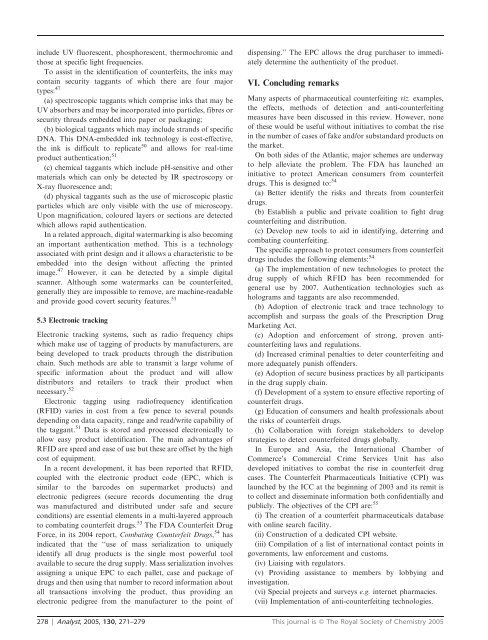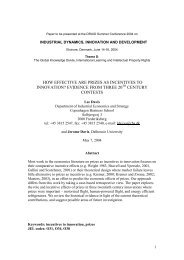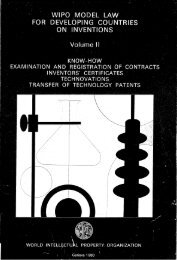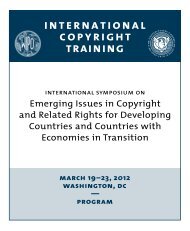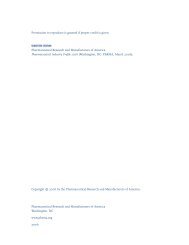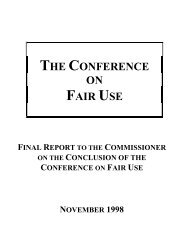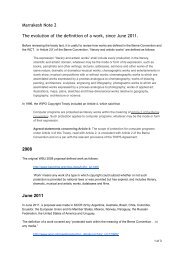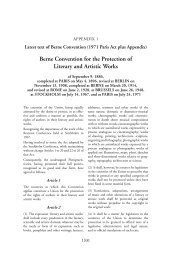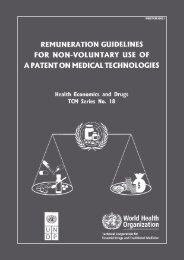include UV fluorescent, phosphorescent, thermochromic andthose at specific light frequencies.To assist in the identification of counterfeits, the inks maycontain security taggants of which there are four majortypes: 47(a) spectroscopic taggants which comprise inks that may beUV absorbers and may be incorporated into particles, fibres orsecurity threads embedded into paper or packaging;(b) biological taggants which may include strands of specificDNA. This DNA-embedded ink technology is cost-effective,the ink is difficult to replicate 50 and allows for real-timeproduct authentication; 51(c) chemical taggants which include pH-sensitive and othermaterials which can only be detected by IR spectroscopy orX-ray fluorescence and;(d) physical taggants such as the use of microscopic plasticparticles which are only visible with the use of microscopy.Upon magnification, coloured layers or sections are detectedwhich allows rapid authentication.In a related approach, digital watermarking is also becomingan important authentication method. This is a technologyassociated with print design and it allows a characteristic to beembedded into the design without affecting the printedimage. 47 However, it can be detected by a simple digitalscanner. Although some watermarks can be counterfeited,generally they are impossible to remove, are machine-readableand provide good covert security features. 515.3 Electronic trackingElectronic tracking systems, such as radio frequency chipswhich make use of tagging of products by manufacturers, arebeing developed to track products through the distributionchain. Such methods are able to transmit a large volume ofspecific information about the product and will allowdistributors and retailers to track their product whennecessary. 52Electronic tagging using radiofrequency identification(RFID) varies in cost from a few pence to several poundsdepending on data capacity, range and read/write capability ofthe taggant. 51 Data is stored and processed electronically toallow easy product identification. The main advantages ofRFID are speed and ease of use but these are offset by the highcost of equipment.In a recent development, it has been reported that RFID,coupled with the electronic product code (EPC, which issimilar to the barcodes on supermarket products) andelectronic pedigrees (secure records documenting the drugwas manufactured and distributed under safe and secureconditions) are essential elements in a multi-layered approachto combating counterfeit drugs. 53 The FDA Counterfeit DrugForce, in its 2004 report, Combating Counterfeit Drugs, 54 hasindicated that the ‘‘use of mass serialization to uniquelyidentify all drug products is the single most powerful toolavailable to secure the drug supply. Mass serialization involvesassigning a unique EPC to each pallet, case and package ofdrugs and then using that number to record information aboutall transactions involving the product, thus providing anelectronic pedigree from the manufacturer to the point ofdispensing.’’ The EPC allows the drug purchaser to immediatelydetermine the authenticity of the product.VI. Concluding remarksMany aspects of pharmaceutical <strong>counterfeiting</strong> viz. examples,the effects, methods of detection and anti-<strong>counterfeiting</strong>measures have been discussed in this review. However, noneof these would be useful without initiatives to combat the risein the number of cases of fake and/or substandard products onthe market.On both sides of the Atlantic, major schemes are underwayto help alleviate the problem. The FDA has launched aninitiative to protect American consumers from counterfeitdrugs. This is designed to: 54(a) Better identify the risks and threats from counterfeitdrugs.(b) Establish a public and private coalition to fight drug<strong>counterfeiting</strong> and distribution.(c) Develop new tools to aid in identifying, deterring andcombating <strong>counterfeiting</strong>.The specific approach to protect consumers from counterfeitdrugs includes the following elements: 54(a) The implementation of new technologies to protect thedrug supply of which RFID has been recommended forgeneral use by 2007. Authentication technologies such asholograms and taggants are also recommended.(b) Adoption of electronic track and trace technology toaccomplish and surpass the goals of the Prescription DrugMarketing Act.(c) Adoption and enforcement of strong, proven anti<strong>counterfeiting</strong>laws and regulations.(d) Increased criminal penalties to deter <strong>counterfeiting</strong> andmore adequately punish offenders.(e) Adoption of secure business practices by all participantsin the drug supply chain.(f) Development of a system to ensure effective reporting ofcounterfeit drugs.(g) Education of consumers and health professionals aboutthe risks of counterfeit drugs.(h) Collaboration with foreign stakeholders to developstrategies to detect counterfeited drugs globally.In Europe and Asia, the International Chamber ofCommerce’s Commercial Crime Services Unit has alsodeveloped initiatives to combat the rise in counterfeit drugcases. The Counterfeit <strong>Pharmaceutical</strong>s Initiative (CPI) waslaunched by the ICC at the beginning of 2003 and its remit isto collect and disseminate information both confidentially andpublicly. The objectives of the CPI are: 55(i) The creation of a counterfeit pharmaceuticals databasewith online search facility.(ii) Construction of a dedicated CPI website.(iii) Compilation of a list of international contact points ingovernments, law enforcement and customs.(iv) Liaising with regulators.(v) Providing assistance to members by lobbying andinvestigation.(vi) Special projects and surveys e.g. internet pharmacies.(vii) Implementation of anti-<strong>counterfeiting</strong> technologies.278 | Analyst, 2005, 130, 271–279 This journal is ß The Royal Society of Chemistry 2005
The battle against counterfeit drugs has only just begun andit will be a long road ahead for those involved in getting rid ofthis illegal trade. The counterfeiters are becoming moretechnologically savvy with the consequence that it is verydifficult to detect sub-standard products. However, developingtechnologies such as near-infrared spectroscopy, Ramanspectroscopy and isotopic characterization can prove usefulin providing rapid detection methods. Furthermore, bymaking use of sophisticated anti-<strong>counterfeiting</strong> measures suchas holograms, taggants and electronic tracking, manufacturerscan trace their products from production to distribution.Peter Lowe of the ICC’s Counterfeiting Intelligence Bureauhas concluded that: ‘‘Despite existing regulatory and legalefforts, the <strong>counterfeiting</strong> of pharmaceuticals remains a veryserious public health concern.’’ 9 This will need widespreadinternational collaboration over the next several years to makeinroads into the counterfeiter’s strongholds.Anil K. DeisinghCaribbean Industrial Research Institute, University of the West Indies,St. Augustine, Trinidad and Tobago. E-mail: anildeisingh@aol.comReferences1 http://www.who.int/medicines/organization.gsm/activities/quality_assurance/cft/counterfeit.2 http://www.fda.gov/oc/initiatives/counterfeit/qa.html.3 C. Clark, Pharm. J., 2003, 271, 453.4 German Pharma Health Fund, http://www.gphf.org/web_en/projekte/minilab/hintergrund-arzneimittelfaelschungen.htm.5 B. Hileman, Chem. Eng. News, 2003, 36.6 Counterfeit <strong>Pharmaceutical</strong>s Digest, issue 3, Autumn 2004, pp. 1,5, London, CIB Counterfeit <strong>Pharmaceutical</strong>s Initiative.7 F. Silva, Phuture, 2003, 7, 3.8 E. Wondemagegnehu, <strong>Pharmaceutical</strong> Counterfeiting: A WHOPerspective, in <strong>Pharmaceutical</strong> Fraud and Counterfeiting, SMIConference Documentation, London, SMI Publishing, 2003.9 ICC Commercial Crime Services, http://www.iccwbo.org/ccs/news_archives/2003/counterfeit_drugs.asp, 2003.10 A. Scheer, http://www.abnh.com/security/Pharm_WhitePaper_WEBSITE.pdf, 2003.11 M. D. Green, P. Newton, F. Fernandez, R. Wirtz and H. Nettey,Simple low-cost strategies to rapidly identify counterfeit drugs indeveloping countries, in Combating <strong>Pharmaceutical</strong> Fraud andCounterfeiting, SMI Conference Documentation, London, SMIPublishing, 2003.12 J. Bassett, R. C. Denney, G. H. Jeffery and J. Mendham, Vogel’sTextbook of Quantitative Inorganic Analysis, London, Longman,4th edn., 1978, pp. 693–696.13 P. Newton, S. Proux, M. Green, F. Smithius, N. Phu, J. Rozendaal,S. Prakongpan, K. Chotivanich, M. Mayxay, F. Noslen andN. White, Lancet, 2001, 357, 1948.14 M. D. Green, D. L. Mount, R. A. Wirtz and N. J. White, J. Pharm.Biomed. Anal., 2000, 24, 65.15 http://www.gphf.org/web_en/projekte/minilab/index.htm, 2003.16 R. Jahnke, The GPHF-Minilab Project, in Combating<strong>Pharmaceutical</strong> Fraud and Counterfeiting, SMI ConferenceDocumentation, London, SMI Publishing, 2003.17 G. Phillips, Pharm. J., 2003, 271, 465.18 P. Pachaly and W. Schick, Pharm. Ind., 1993, 55, 3, 259–267.19 B. W. Hadzija and A. M. Mattocks, Forensic Sci. Int., 1983, 23,143–147.20 C. L. Flurer and K. A. Wolnik, J. Chromatogr. A, 1994, 674, 1–2,153–163.21 Microgram Bulletin, June 2004, http://www.usdoj.gov/dea/programs/forensicsci/microgram/mg0604/mg0604.html(13th August2004).22 Microgram Bulletin, April 2004, http://www.usdoj.gov/dea/programs/forenscisci/microgram.mg0404/mg0404.html(9th August2004).23 K. J. Mulligan, T. W. Brueggemeyer, D. F. Crockett andJ. B. Schepman, J. Chromatogr. B, 1996, 686, 85–95.24 A. Belu, S. Bryan, M. C. Davies and N. Patel, Secondary Ion MassSpectrometry, SIMS XII, Proceedings of the InternationalConference on Secondary Ion Mass Spectrometry, Brussels,September 5–10 1999, 2000, pp. 919–922.25 T. Decaestecker, K. Clauwaert, J. Van Bocxlaer, W. Lambert,E. Van den Eeckhout, C. Van Peteghem and A. De Leenheer, Adv.Mass Spectrom., 2001, 15, 377–378.26 H. Shen, J. F. Carter, R. G. Brereton and C. Eckers, Analyst, 2003,128, 287.27 K. E. Arthur, J.-C. Wolff and D. J. Carrier, Rapid Commun. MassSpectrom., 2004, 18, 6, 678–684.28 J.-C. Wolff, L. A. Thompson and C. Eckers, Rapid Commun. MassSpectrom., 2003, 17, 3, 215–221.29 R. J. H. Waddell, N. NicDaeid and D. Littlejohn, Analyst, 2004,129, 235–240.30 D. A. Skoog and J. J. Leary, Infrared Absorption Spectroscopy, inPrinciples of Instrumental Analysis, Saunders, Philadelphia, 4thedn., 1992, pp. 252–289.31 F. Gonzalez and R. Pous, J. Pharm. Biomed. Anal., 1995, 10, 419.32 M. Blanco, J. Coello, H. Iturriaga, S. Maspoch and C. de laPezuela, Analyst, 1997, 122, 761.33 S. H. F. Scafi and C. Pasquini, Analyst, 2001, 126, 2218.34 J. J. Workman, Appl. Spectrosc., 1996, 31, 251.35 F. C. Clarke, S. V. Hammond, R. D. Jee and A. C. Moffat, Appl.Spectrosc., 2002, 56, 1475.36 Perkin Elmer http://las.perkinelmer.com/content/applicationnotes/006832_01.pdf.37 D. A. Skoog and J. J. Leary, Raman Spectroscopy, in Principles ofInstrumental Analysis, Saunders, Philadelphia, 4th edn., 1992,p. 297.38 C. M. Hodges and J. Akhavan, Spectrochim. Acta, Part A, 1990,46, 303.39 A. G. Ryder, G. M. O’Connor and T. J. Glynn, J. Forensic Sci.,1999, 44, 1013.40 S. E. J. Bell, D. T. Burns, A. C. Dennis, L. J. Matchett andJ. E. Speers, Analyst, 2000, 125, 1811.41 S. Bell, D. Burns, A. Dennis and J. Speers, Analyst, 2000, 125, 541.42 S. E. J. Bell, L. J. Barrett, D. T. Burns, A. C. Dennis andS. J. Speers, Analyst, 2003, 128, 1331.43 B. O’Rourke, Irish Scientist, http://www.irishscientist.ie/2002/contents.asp?contentxml502p996xml&contentxsl5ls02p.44 http://www.molecularisotopes.com/pharm.html, 2004.45 J. P. Jasper, Fire Arson Invest., 2002, 51, 2, 30.46 J. P. Jasper, J. S. Edwards, L. C. Ford, R. A. Corry, F. Fourel andA. Eaton, Abstract, International Technical Working Group on Fireand Explosives, 2002, Orlando, Florida.47 R. Jotcham, Understanding and Evaluating Security Technologiesfor <strong>Pharmaceutical</strong>s, in Combating <strong>Pharmaceutical</strong> Fraud andCounterfeiting, SMI Conference Documentation, London, SMIPublishing, 2003.48 J. Prebble, Thieves take the wrap, http://www.piranet.com/admin/_private/TechnicalArticles/00126.pdf, 2003.49 http://www.holoprotec.com, 2004.50 http://www.findarticles.com/cf_dls/mOEIN/2003_Oct_17/108987951/p1/article.html, 2003.51 A. Shanley, Drug Makers Strike Back, http://www.pharmamanufacturing.com/Web_First/PhM.nsf/ArticleID/ASHY-5TAPDX,2003.52 http://www.fda.gov/oc/initiatives/counterfeit/backgrounder.html,2003.53 http://www.sun.com/smi/Press/sunflash/2004-02/sunflash.20040219.2.html, 2004.54 http://www.fda.gov/oc.initiatives/counterfeit/report02_04.html.55 P. Lowe, Fighting the Problem: The ICC’s new counterfeitpharmaceuticals initiative, in Combating <strong>Pharmaceutical</strong> Fraudand Counterfeiting, SMI Conference Documentation, London,SMI Publishing, 2003.This journal is ß The Royal Society of Chemistry 2005 Analyst, 2005, 130, 271–279 | 279


